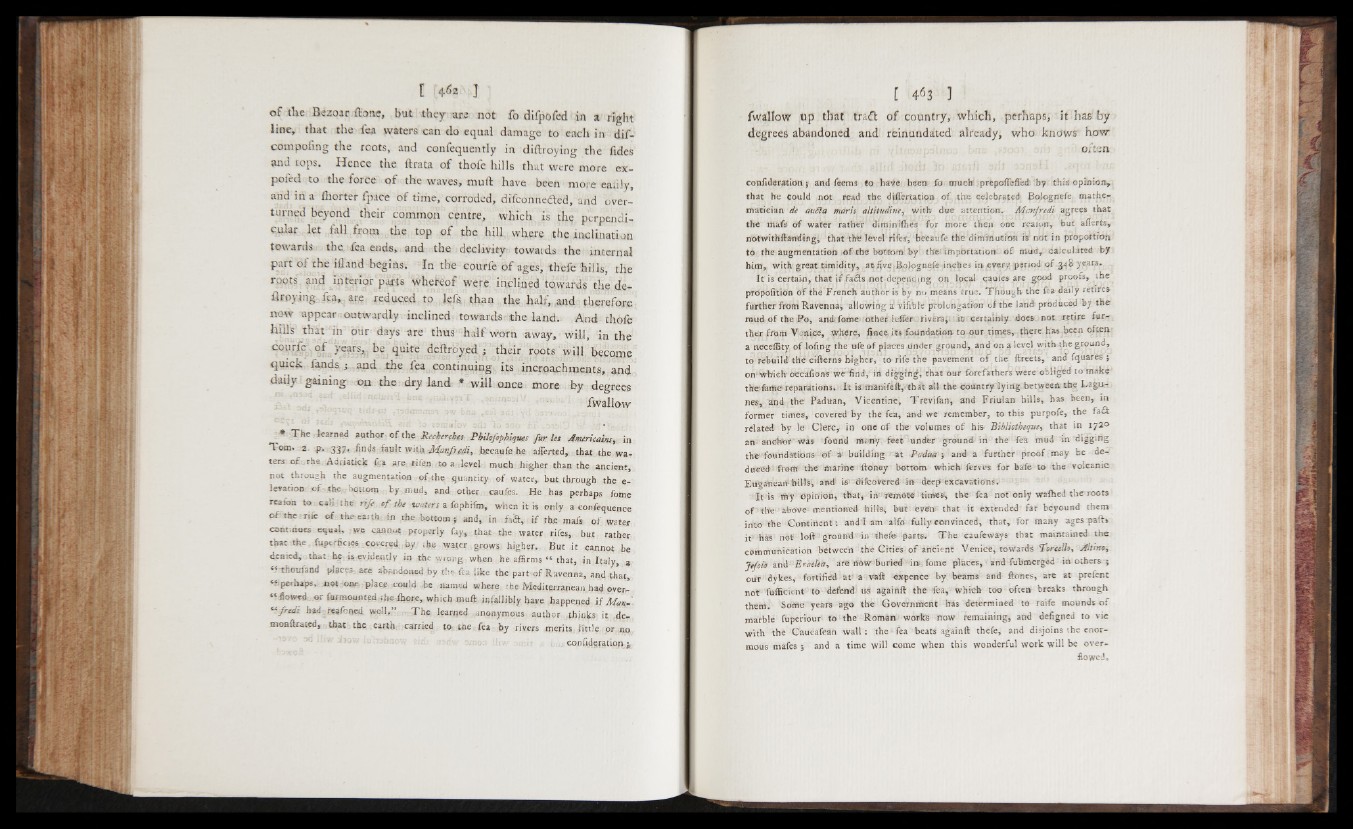
o f the Bezqac ffioae, but they ari not fo difpofed in a right
line^ that the fea waters can do equal damage to each in dif-
compofing the roots, and confequently in diftroying the fides
and tops. Hence the ftrata of thofe hills that were more expoled
to the force o f the waves, muft have been more ealily,
and in a fhorter fpace o f time, corroded, difconhefted, and overturned
beyond their common centre, which is the perpendicular
let tall from the top o f the hill where the inclination
towards the tea ends, and the declivity towards the internal
part oi the iiland begins. In the courfe o f ages, thefe hills, the
roots and interior parts whereof were inclined towards the de-
ilrojing. fea, are reduced to lefs, than the halt, and therefore
now appear outwardly inclined towards the land. And thofe
hills that in our days are thus half worn away, will, in the
courfe\ o f years, be quite deftrbyed; their roots will become
quick fands •, and the fea continuing its incroachments, and
darly gaining on the dry land * will once more by degrees
fwallow
* Th e learned author e f the Recierehet PbUofiphiqu's fur Us Amen,coins, in
Tom. 2 p. 337. finds fault witii ¿\4atifrcdi, becaufe he afierted, that the waters
o f.rh e Adriatic^ (ca are rifen to a level much higher than the ancient,
not through the augmentation o f the .quantity of water, but through the e-
leration of the IxHtom by mud, and other caufes. He has perhaps fame
reaton to cali the rife, of the waters a fophifm, when it is only a confequence
of- the rife of the earth in the bottom j and, in fa&, i f the mafs of water
continues: equal, we cannot properly fay, that the water rifes, but rather
that the fuperficies covered .fey . He water grows higher. But it cannot be
denied, that he is evidently in the wrong when he affirms “ that, in Italy, a
‘ f thoufand places ate abandoned by the fea like the part-of Ravenna, and that,
“ ¡perhaps, not one place could he named where the Mediterranean had oveiC
“ flowed or fur mounted the-fhot^, which muft infallibly have happened i f ManJs
“ fredi had reafoned well,” T h e learned anonymous author thinks it -de-
moaftrated, that the earth carried to the fea by rivers merits little or no
, confidsration;
fwallow up that trail of country, which, perhaps, it has by
degrees abandoned and reinundated already, who knows how
often
confideration j and feems to have been fo much prepoffeffed by thitf opinion,
that he could not read the diftertation of-the. celebfated1 Boiognefe: mathematician
de an Sla maris alfitudine, with due attention. Mcnfredi agrees that
the rtlafs of water rather diminifhes for more then one real on, but ailerts,
notwithftanding^ that the level rifes, becaufe the diminution is not in proportion
to the augmentation o f the bottom by the; importation o f mud, calculated by
him, with great timidity, atitve.Bqjognefe inches in every period o f g^&years.
It is Certain, that if fadts .not-depending on local caules are good proofs, the
proportion of the French author is by no means true. Though- the fea daily retires
further from Ravenna», allowing a vifible prolongation of the land produced by the
mud o f the Po, andTome other ledfer rivfe^ ¿6 certainly does not retire further
from Venice, where, fence its foundation, to our times, there has been often
a neceflky of lofing the ufe of places Under ground, and on a level with the ground,
to rebuild the citterns higher, to-rife the pavement o f the ftreets, arid fquares ;
on1 which* occafions we find, id digging* that our forefathers were obliged to make
the*feme'reparations* It is rttânifèftythit all the country lying between the Lagunes,
and the Paduan, Vicentine* Trevifen-, and Friulan hills, has been, in
former times,, covered by the fea, and we remember, to this purpofe, the fa£fc
related by le Clerc,- in one of the volumes of his Bibliothèque, that in 1720
an anchor was foüfld rivèffy feet under ground in the fea mud in digging
the* foundations of a/ building at Padua y and a further proof may be deduced
from the marine ftoney bottom which ferves for baie to the volcanic
Eügabeam hills', and ¡6- difcoVered in deep excavations.- :
It is m*y Opinion, t h a t , l i m e s , the fea not o n l y waihed the roots
of * the* above- mentioned hills., but even; that it extended far beyound them
into the Continent : andi am alfo fully convinced, that, for many ages paft*
it^ has not loft 'ground in*ihefe- parts* T h e caufeways that maintained the
communication between the Cities of ancient Venice, towards Toreello^ Alt inn ^
Jefofo and Exaclia, arë riOW ’buried ir*. fome places, and fubmerged in others ;
our dykes, -fortified a t a vaft expence by beams and ftones, are at prefent
not futticient to defend usi againft: the fea, which too often breaks through
them. Soirte years ago the Government has determined to raife mounds o f
marble fuperiour to the Roman works now remaining, and defigned to vie
with the Gaucafeàn wall : the fea beats againft thefe, and disjoins the enormous
mafes 5 and a time will come when this wonderful work will be overflowed
»